#male eclectus
Text
Hung out with Apollo

#cute#kawaii#birbs#pet bird#best birbs#cute birbs#i love birbs#smol birbs#birbs of tumblr#male eclectus#eclectus parrot#eclectus#parrot#parrots
509 notes
·
View notes
Note
Can you post your top 5 sex dymorphisms in birds? Some are really funny, like I remember there is a bird whose females are dull green but males are German flag hghhfhjn
Well, to me, some of the most striking sexual dimorphism occurs amongst the birds of paradise, family Paradiseaidae, order Passeriformes, of New Guinea...
Photographs by Tim Laman

Red Bird-of-Paradise (Paradisaea rubra)

Magnificent Bird-of-Paradise (Diphyllodes magnificus)

Twelve-wired Bird-of-Paradise (Seleucidis melanoleucus)
There's also one of my favorite birds...

Painted Bunting (Passerina ciris), female and male, family Cardinalidae, order Passeriformes, LA, USA
photograph by Bonnie Taylor Barry
I also love the dimorphism of birds where the female is actually more colorful...
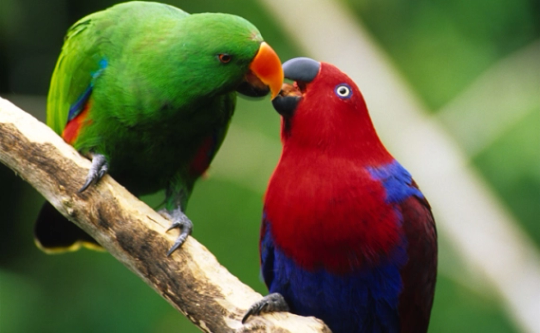
Moluccan Eclectus Parrot (Eclectus roratus), male and female, family Psittaculidae, order Psittaciformes, native to the Maluku islands of Indonesia
photograph by Papagoi Keskus – Erispapagoi
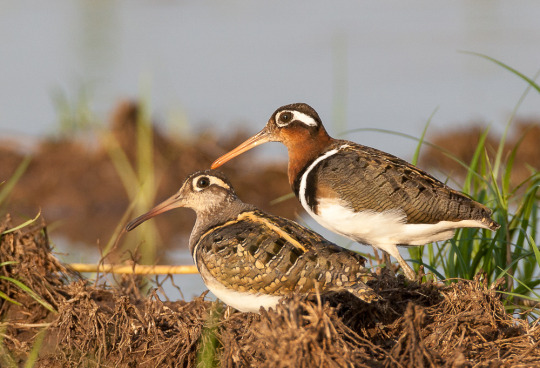
Greater Painted Snipe (Rostratula benghalensis), male and female, family Rostratulidae, Kenya
photograph by Wim de Groot
409 notes
·
View notes
Text
male eclectus parrot needle felt!


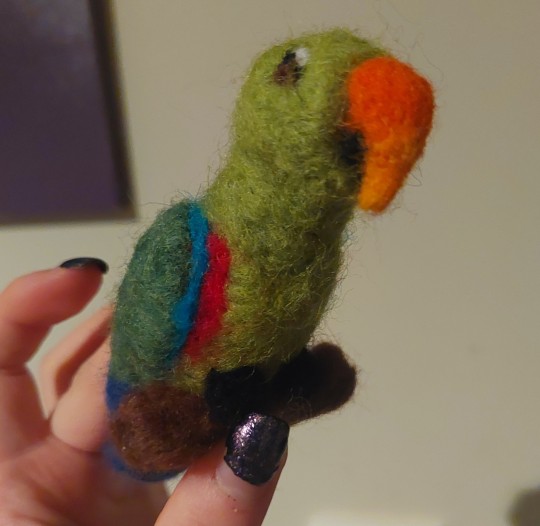

#bird#birds#bird art#ornithology#special interest#eclectus#one of the most intresting birds ive seen! maybe ill make a female eclectus next#i broke FIVE needles making him#needle felting#i wanted to give him his zygodactyl feet but i only had one needle left and could not risk it#parrot
340 notes
·
View notes
Note
Is owning an ekkie difficult? what should you know about ekkie’s before getting one?
first off, as with all parrots i would NOT encourage you buy one as a pet. Theyre not domesticated and i dont think they should be bred and sold as pets, so if you can, get a rescue, or dont get one at all as they are a massive, massive commitment. (i have monty, hes a rescue,i love him. if i could put him back in the wild and be sure hed be able to survive, id put him there)
that said, its up to you. ill put some bird/eclectus care stuff under the readmore
necessary things to have on your part:
-a job and social life that allow you to spend hours at home with your ekkie, training them and giving them attention- training is necessary to keep them happy and mentally healthy and it also will really assist the two of you bonding :>
- the budget to provide them with a serving of fruits+vegetables twice a day. An all seed diet will kill an eclectus, as they are fruit eaters (do not feed avocado, rhubarb, chocolate or things containing caffeine. birds are lactose intolerant afaik. consult google for full list of what not to feed a parrot. human spit is also toxic)
-willing to commit 30+ years of your life to this
-budget for toys
-budget for annual exotic pet vet visits (NOT CHEAP!)
-acceptance that eclectuses dont really like scritches. theyre strange like this, do not force scritches upon them. kisses are fine
-love and patience, theyre intelligent animals and they can give you the runaround, or bite, or destroy a beloved possession. the cheekiness is part of the fun a lot of the time.
great things about ekkies (can only speak for my experience with monty who is male, ive heard females can be different, and of course every bird is a little bit different so milage may vary):
-generally quiet, but very able to chat up a storm when something interesting is afoot
-loving and caring but in a beaky kind of way
-i don’t believe theyre usually ‘single person’ birds, and have it in them to love a whole gaggle of people. monty loves parties.
-very smart. enjoys a puzzle treat box
-sooooo cheeky
DO NOT:
-stroke a birds back or under the wings. it’ll make them horny and frustrated
-let it sit in the cage alone for hours and hours with no engagement. toys and time with you are essential
-let it stay up too late. too many hours of light make a bird horny and frustrated
-let it have access to electrical cables, copper toys, anything Not Bird Safe.
ive probably missed something important, if i have feel free to add on in the replies
487 notes
·
View notes
Note
I was wondering if you could help me. I’m making a character and it’s a bird alien, do you know of any bird species where the female is more colorful then the male? people tell me it’s a thing but I can’t find any birds on the matter. Im having a hard time believing it…
It’s pretty uncommon, but the Eclectus parrot is a great example!
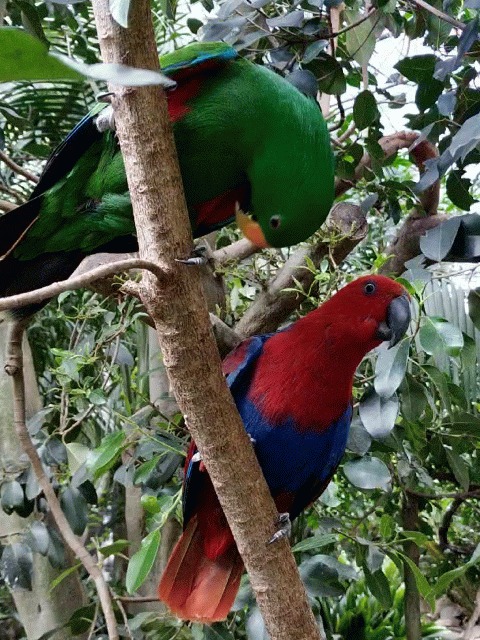
The green bird is a male, the red is the female. The male isn’t particularly dull, but usually really vibrant reds or blues are found in males, not females.
224 notes
·
View notes
Text
ornithologists: ok so the male birds are more vibrant and unnatural (reds, yellows, blues, etc) colors to attract potential mates, and the female birds are more dull or natural colors (greens, browns, etc) to blend in with their surroundings.
eclectus parrots: *exist*
ornithologists: tf
21 notes
·
View notes
Note
i think you once mentioned something about certain parrots (eclectus iirc) using changes in light on their feathers to communicate, could you talk about that some more plz
yeah of course!
so it’s actually all parrots that do this! parrots can see the ultraviolet colour spectrum, which makes them look very different to each other than they do to us. to other parrots, the colour of their feathers will change depending on how light hits them (this isn’t true iridescence because that comes from the physical structure of the feather, but it likely has a similar effect), and this is a big part of how they communicate with each other. parrots will move their bodies and feathers minutely to change how the light hits them, essentially changing the colour other parrots view them as, which will be a much more obvious cue to each other than it is to us - we can still see the way they move, but it’s not as easy for us to see. this can cause a lot of miscommunication between human and parrot, with how some social cues may be very obvious to them while those same cues appear very subtle to us. understandably, this can be really frustrating to parrots, and is one of many reasons parrots shouldn’t be pets. but in terms of eclectus parrots, their ultraviolet colouring is important to them in other ways! female eclectuses can spend up to 10 months of the year nesting in dark tree hollows. when they’re expecting food from males, females will sit at the entrance of the hollow, and their red feathers will blend in really well in the shadows, hiding them from predators (raptors) that cannot see ultraviolet light. the males, though, are able to clearly see any females in their tree hollows because the ultraviolet light makes them appear very different. to raptors that may hunt them, females in the nest (who are almost always guarding eggs/chicks, as well as having slower reaction times or even slightly atrophied muscles depending on how long they’ve been in the nest) are hard to see in the shadowy hollows. but to other eclectuses, females appear brightly coloured and easy to see from far away - this helps the males find females and also advertises to other females that a nest is taken. the strange breeding behaviour of eclectuses is the reason males and females are so different from each other - females are designed to camouflage in dark crevices, while males are designed to camouflage in bright green foliage, because females spend most of their time in the nest and males spend most of their time foraging. idk i think colour vision in parrots is really cool
17 notes
·
View notes
Text
Moluccan Eclectus Parrot (Eclectus roratus)

"just read about em in a book and they're so fascinating! the males and females are completely different colors to the point scientists assumed they were different species for years. they are also unique in that their babies are born sexually dimorphic in their colors! overall very interesting little guys"
"I own one. He’s loud. I love him. Also they’re one of the only kinds of parrots with sexual dimorphism. Look em up. They both look crazy different. In fact, they thought they were two different kinds of birds for a loooong time."
The breeding behavior for this species is wild. Females are thought to be so brightly colored as they will guard the entrance to their nest cavity for up to 11 months at a time. The coloration serves as a deterrent to other females, but also highlights her presence to males in the area. One female eclectus can have multiple males that feed and mate with her, and males will take care of multiple females at a time as well. The male's green coloration helps to camouflage him against the leaves and trees as he forages. It is noted that the plumage of both sexes is quite spectacular when viewed under ultraviolet light, a type of light that they predators (hawks and owls) cannot see in.
"Adult females with poor nest hollows often commit infanticide on the male, if they produce both a male and a female chick. Inadequate nest hollows have a habit of flooding in heavy rain, drowning the chicks or eggs inside. This reported infanticide in wild pairs may be the result of other causes, since this behavior where the hen selectively kills male chicks is not observed in captive birds."
Sources:
Image Source: eBird (Doug Herrington)
#in memoriam (joke)#Eclectus roratus#eclectus parrot#Moluccan Eclectus#psittaculidae#australian birds
23 notes
·
View notes
Note
🦜 another one hehe :)))
Eclectus parrots are the most sexually dimorphic parrot genus, to the point where males and females of all the species were considered separate species due to being so different.

The male is green on the left, and the female is red/purple on the right.
Parrots in generally don't have much sexual dimorphism, and the in the majority of parrot species it's impossible to tell without doing DNA sexing for chromosomes, or just waiting for a parrot to lay eggs (which may never happen).
3 notes
·
View notes
Text
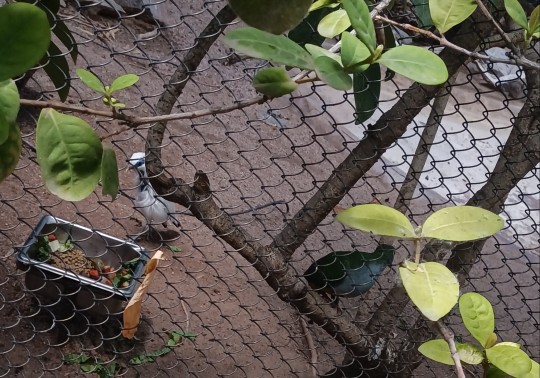
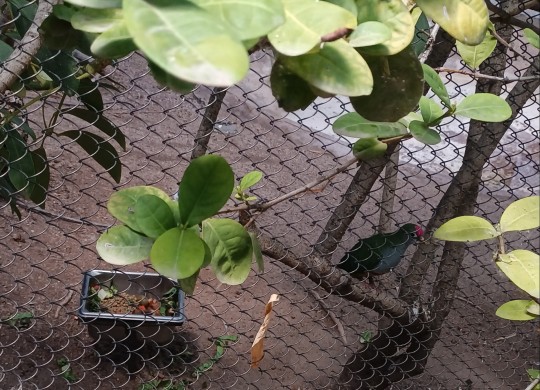
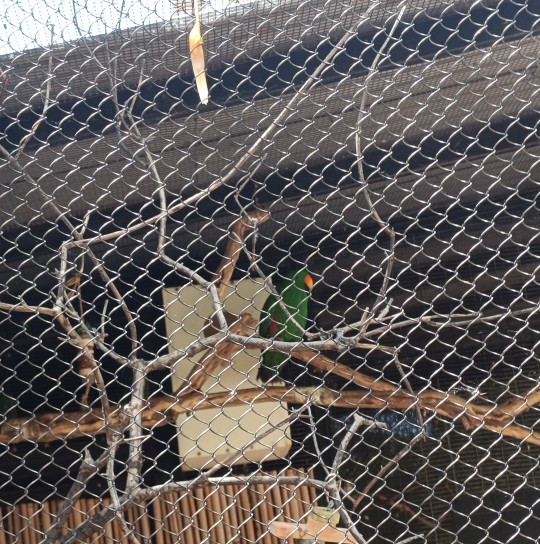
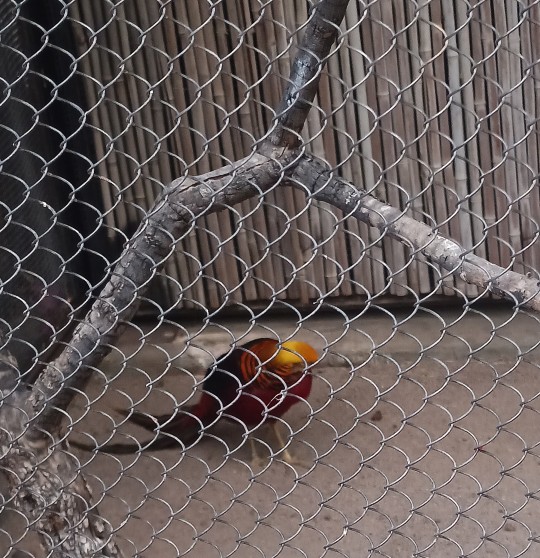

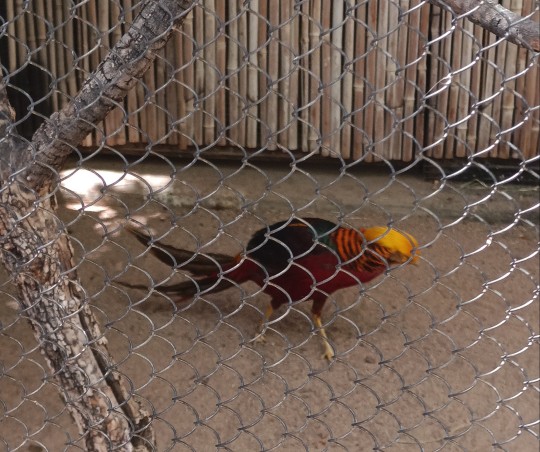
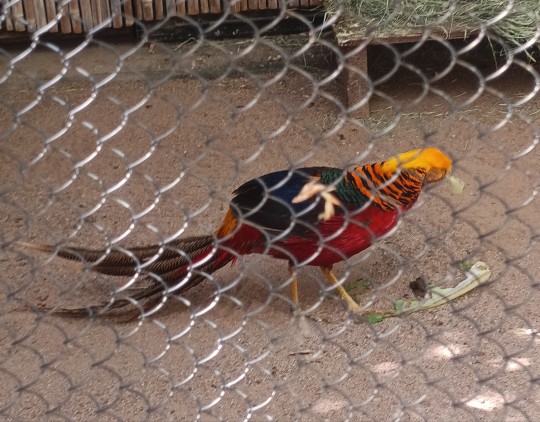
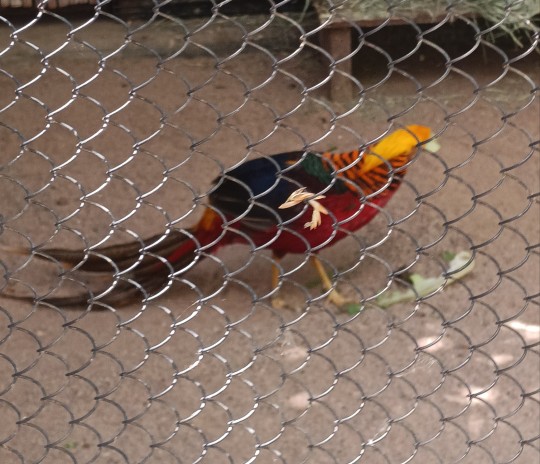
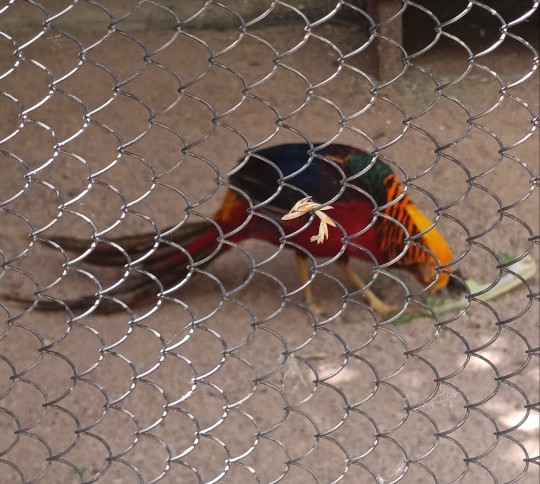

Some more birdies, that white one in the top left picture was so food protective any time one of the doves got too close to the food, a male eclectus parrot and a beautiful golden pheasant waking up to munch on some romaine
4 notes
·
View notes
Photo

uSCP-7158: The Paradoxical Parrot
Object Class: Safe
Special Containment Procedures: uSCP-7158 is to be contained in a standard avian containment unit at Site-██. Access to uSCP-7158 is restricted to Level 2 personnel or higher and must be approved by at least two Level 3 personnel.
Personnel interacting with uSCP-7158 must wear ear protection to prevent the parrot's anomalous effects. Any personnel who have been exposed to uSCP-7158's effects must undergo a psychiatric evaluation before resuming duties.
Description: uSCP-7158 is a male Eclectus parrot of unknown origin. The parrot appears to be non-anomalous in all aspects except for its ability to speak.
When uSCP-7158 speaks, it produces a paradoxical effect on the listener's perception of time and reality. Listeners report feeling as if they have experienced both the past and the future simultaneously, causing severe disorientation and potential psychological trauma.
The extent and duration of this effect vary depending on the individual listener and the content of uSCP-7158's speech. The effect can range from mild disorientation to full-blown hallucinations and delusions.
Attempts to record uSCP-7158's speech have been unsuccessful, as the paradoxical effect appears to be tied to the parrot's physical presence. It is unknown how uSCP-7158 is able to produce this effect or the full extent of its abilities.
Addendum: Recent experimentation has revealed that uSCP-7158's paradoxical effect can be mitigated by playing certain types of music in its vicinity. The use of classical music has been observed to significantly reduce the severity and duration of the effect.
Note: Due to the potential psychological trauma caused by uSCP-7158's anomalous effects, all personnel are reminded to adhere strictly to the containment procedures and to report any abnormalities or breaches immediately. The full extent of uSCP-7158's abilities and effects remains unknown and requires further study.
Audio
21 notes
·
View notes
Text
The Gang and their Pets
-- More headcanons that I have that make no sense
Taglist: @mavswife @blessupblessup @unsurebuttrying @dempy --
Hangman:
- Main Coon or Ragdoll cat
- Something either expensive or that requires a lot of mainenance
- I firmly believe he is a cat person (am I projecting? Probably.)
Rooster:
- Labrador or Golden Retriever
- Let's be honest here, our man is the human equivalent of a Golden Retriever anyway so it's only logical
Phoenix:
- German Shepherd or Belgian Malinois
- Something scary and efficient
- Doesn't like cats because they're "shady"
Bob:
- Anything the animal shelter sends his way tbh
- Bob likes animals about as much as he likes babies so a whole lot. He just has a lot of love to give y'know?
Coyote:
- Has an american shorthair cat but he desperately wants a husky
- Absolutely will dogsit for you
Fanboy:
- I don't know what a bird person looks like but Idk why, I feel they look like Fanboy
- He has a male Eclectus parrot named Pickles
Payback
- German Shepherd
- He has it mainly for protection (not his)
Mav:
- Don't give Mav a pet, he can barely remember to feed himself...
Penny:
- Golden Retriever
- Got it for Amelia three years ago but it prefers her so it's her dog now
Cyclone:
- Chihuahua
- idk why I just feel like he has one
Hondo:
- Does Mav count as a pet? I mean he does spend half his day picking up after him?
- Maybe a bulldog?
#fanfic#top gun fanfiction#top gun maverick#top gun x reader#fanfiction#hangman x reader#jake hangman seresin#jake seresin#hangman top gun#bradley bradshaw fic#bradley rooster bradshaw#robert bob floyd#bob x reader#bob floyd#natasha phoenix trace#phoenix x reader#phoenix#coyote x reader#javy coyote machado#coyote#mickey fanboy garcia#hondo#beau cyclone simpson#payback#reuben payback fitch
145 notes
·
View notes
Text
BOTD: Eclectus Parrot
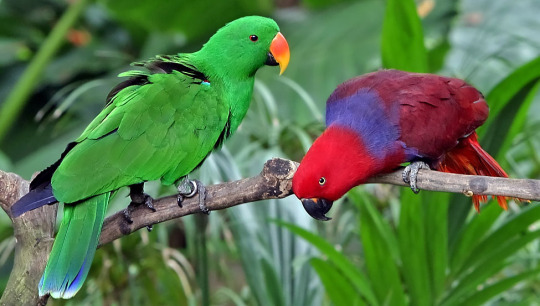
^image credit: Doug Janson, Wikipedia
Eclectus Parrot (eclectus roratus)
The Eclectus Parrot is unusual in parrot species in that they exhibit extreme sexual dimorphism, with the male and female having such different plumage that the first ornithologists to discover them believed them to be different species. The males are mostly a bright emerald green, whereas the females are a deep red and purple.
#eclectus parrot#parrots#bird of the day#birding#birdwatching#tropical birds#bird facts#birdlife#wildlife#ornithology#parrot#parrot facts#facts about birds#animal facts#zoology#bird#birds#birb
58 notes
·
View notes
Note
its late so im having those Goofy Bedtime thoughts but i started thinking about eclectus parrots. will the female end up turning green at some point? and if not, what is it about peacocks specifically that makes them trans?
Absolutely nothing, it's just a thing birds do. We notice it in peafowl (and chickens and ducks) because they're domesticated, sexually dimorphic, have lifespans where it's observable, and we know how to care for them well enough for them to live past henopause. If a female eclectus has an ovary that malfunctioned or lived long enough to outlive her ovary's use, she would indeed change plumage.
Unfortunately, parrots are... They're not domesticated and most people keeping them suck at meeting their needs appropriately. Not everyone, but enough people that we're constantly seeing them end up in rescues, ending up plucked from stress, ending up in emotionally damaged shambles because they outlive their owners, etc. I don't really think people should be keeping them as pets in the first place for a lot of reasons, which is a very unpopular opinion with the many people that keep them. But I'm not trying to say that those people are bad, just that an industry has been created which puts a lot of people in a very bad position taking care of an animal that humans at large don't have adequate knowledge or resources to care for in a way that the animal needs, and that often results in a bad situation for the animal. My start in birds was volunteering at a parrot rescue and seeing all the damage done up close and personal to surrendered birds really drove home the point for me. So to that end? I don't think we're seeing eclectus that live until they would change, which is assuming they have few enough eggs in the first place for their ovary to retire before the rest of their body does.
I wouldn't be surprised to find that some "male" eclectus parrots would actually blood test as hens if anyone bothered but since they're supposed to be sexually dimorphic, it wouldn't really matter unless you were breeding them, and the assumption would likely be "oh he's sterile" or "the hen doesn't like him" before "oh he's got hen bits on the inside." It just wouldn't occur to people since they don't know it happens. But I bet they're out there.
48 notes
·
View notes
Text
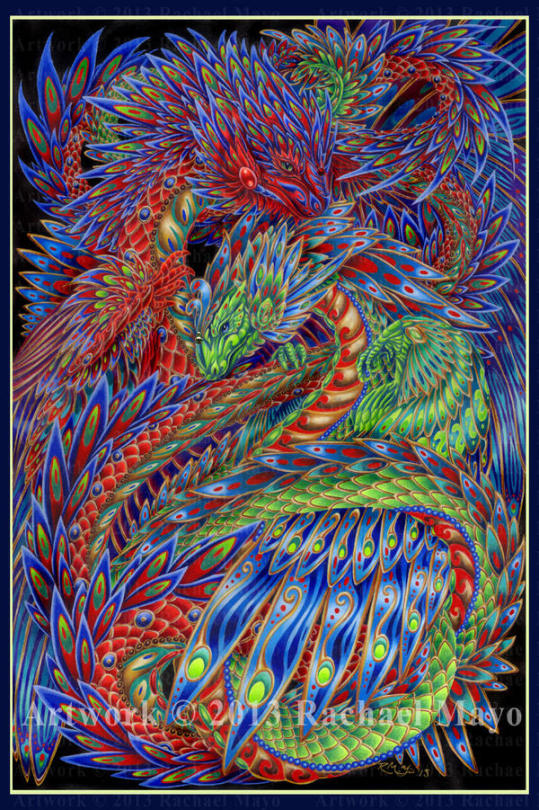
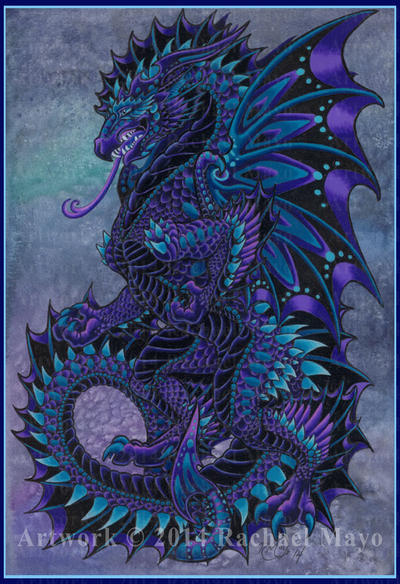
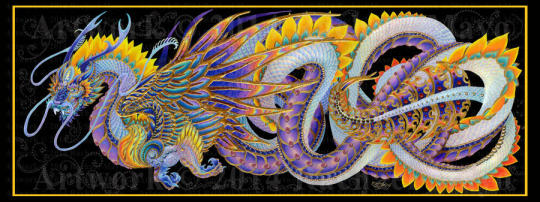
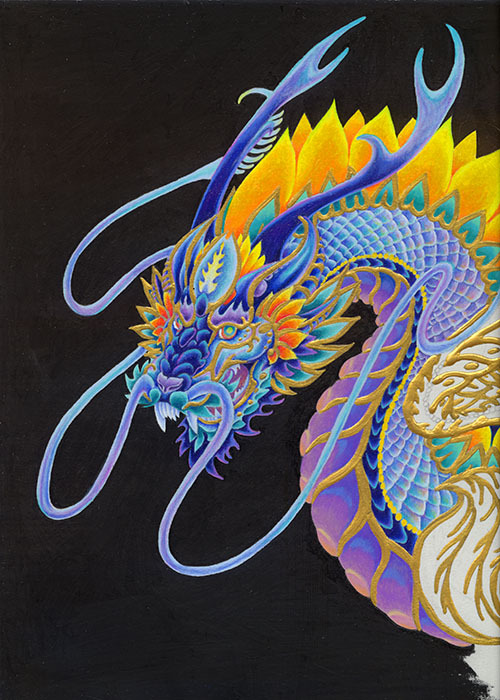
Here are some other dragons that are related to the Stone Dragon series.
First is Flamma Vitae, a commissioned piece for my sister and her husband. I used their birthstones, ruby and peridot, as the point of departure for the dragons' colors. I was also thinking about eclectus parrots, though the male/female colors are reversed in this case.
Second is Onyx Herald, another commissioned piece. Its color set and the dragon-rampant format were specifically requested by the commissioner. And oh, darn, I do so loathe working in this color range... Heehee.
Third is my most recent foray into the opal family, Opal Paradigm. There's a detail of the face as well.
Opal Paradigm was a "because I can" piece. I wanted to challenge myself, so I designed this dragon on a 15x36 inch board, and went all out on opalescence for its body. Success is still hit-and-miss, but I still really like the way it turned out. It also has a lot of additional mediums, including gold acrylic paint for some of the trim, rhodonite and red jasper stones on the body, as well as a white opal stone on the head, and a veritable boatload of shiny bits. I think there's glitter glue in there, also. It was fun. It was a hell of a lot of work - probably 100+ hours, spread over several weekends.
7 notes
·
View notes
Note
Hey? You know that bird?? The one that is trans? The one on your blog, can you show me that bird again, or like pictures of examples of how birds change plumage and go from female to male? I cannot seem to find many pictures online :(
sure can!



image id: an eclectus parrot with a mostly green head, dappled with some red feathers, red feathers tipped with green on the neck, a half-plucked blue chest and abdomen, blue ventral wings, dark red wing feathers tipped with green, light eyes with wide dark pupils, and a black bill with the upper mandible streaked yellow and orange. there are some grey and white down feathers sticking out on her wings and chest from plucking. the other two images are pictures of the same bird, one a more zoomed out shot from a different angle, and one a close-up headshot. end id
the best pics of her i could find

image id: an eclectus parrot with a mostly red head, a green forehead and crown, a green chest dappled with blue, red patches underneath the wings, dark red wings with some green feathers, blue flight feathers, brown eyes, the upper mandible of the bill orange and yellow with a small streak of black, and a black lower bill mandible. end id
here’s another example of an eclectus parrot with marbled male/female plumage, his name’s atlas and he belongs to u/midgetcanadian iirc on reddit! this pic is from a long time ago actually, he’s gone fully green with regular male colouration and was dna tested to be male. he’s essentially the opposite case of the bird i work with, whereas she spent the first 15-odd years of her life with regular female colouration and started turning green after she bonded with an african grey we presumed to be male. that african grey has since passed away four-ish months ago, so we’ll see if his absence has any effect on her plumage.
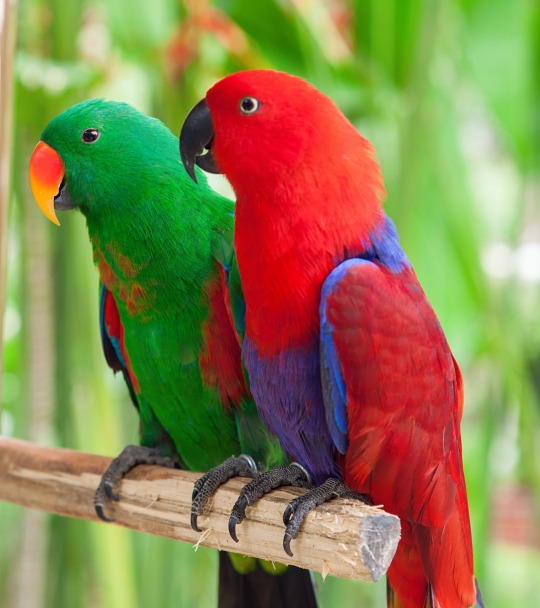
image id: two eclectus parrots, one male and one female. the male is mostly vibrant green, with patches of red under his wings, blue flight feathers, dark eyes, an orange and yellow top bill mandible and black lower mandible. the female has a bright red head and neck and darker red wings with a blue chest and body, blue on the ventral side of the wings, light eyes, and a fully black bill. end id
this is an example of regular male/female colouration (apart from the few red feathers on the male’s neck). they’re very distinguishable, so much so that ornithologists thought they were different species for years.
switching to different sexes like this actually isn’t unheard of in birds. sometimes, when a hen’s ovaries stop working for whatever reason, she will start behaving more like a cock, and if the species is sexually dimorphic, begin to appear like one, too. bird sex is a lot more fluid than human sex is as they have a completely different chromosomal system (Z and W chromosomes as opposed to humans’ X and Y), and birds can actually control the sex of their chicks if need be. zebra finches, for example, will begin producing more females if the flock is having a difficult time, and kookaburras always tend to hatch a male before a female.
it’s actually not super rare for female birds to suddenly “become” males when their sex organs stop working. this is especially common in domestic chickens, ducks, peafowl, but that’s likely just because it’s a lot easier to monitor them and take notice of when it’s happening. but why do birds never seem to change from males to females? it’s because, like how a humans’ default sex is female, all birds’ default sex is male. so it’s not like a bird has never been born intersex and had characteristics of both sexes/changed appearance from male to female over time, it’s just a lot more rare, since when a female’s defining female trait (ovaries) stops working, sometimes their bodies then default to male and a hen chicken would grow large, ornamental tail feathers, grow larger combs, and begin crowing. when a bird’s ovaries stop working, they stop producing oestrogen, and so they take on more male traits as a default. sometimes they develop testes as well, and there’s even been a case of a previously female bird siring viable offspring as a male. some birds have even been found to be gynandromorphic, where their secondary sex characteristics (plumage, flesh/beak colouration, fat distribution, etc) are split male/female neatly down the middle of their bodies.
so does this mean that millie (the first eclectus) is trans? yes and no, but mostly no. in a human sense, millie would not be trans, primarily because birds have no sense of gender. obviously this doesn’t mean she’s “cis” either; she just is. to call her trans would be gross anthropomorphism, which is ideally to be avoided at all costs when it comes to real life animals. however, as long as you’re aware that sex is a very complicated matter and that she’s not truly trans in the human understanding of it, i don’t see an issue with casually referring to millie and any other female-male birds as trans! we don’t fully understand what’s going on with millie in regards to her ovaries/testes and hormones, because as much as universities and labs want to study her, we don’t want to stress her more than is strictly necessary, and since her partner died, we won’t be handing her off to some scientist anytime soon. all we know is that millie is somewhere between male and female, and it’s not the rarest thing in the world that she seems to be switching from female to male. but in the case of atlas, the second eclectus above, his case was likely just a result of confused hormones while he was young, as he’s got entirely normal male characteristics now, and he was very young (1-2 years i believe) while he was marbled like that.
so yeah, bird sex is a very interesting thing to study and i am very lucky to have such a great example of sex switching in birds right at my own aviary!
(just as a side note: millie is unusual for two reasons! one is her sex switch, and the other is the fact that she bonded with an african grey like she did. parrots are very social animals and most of them form bonds for life, most parrots being monogamous and forming strong emotional bonds with their partners, african greys included, but eclectuses are the only exception to this. they are the only parrot species that isn’t monogamous; a female will mate with many different males over their lives, and males can tend to many different females at once. females will stay in their nest hollows for at least six months straight of the year, depending entirely on her many mates to bring her food, and males will spend all day every day bringing food to various females. millie was a strange outlier for bonding so closely to her mate, but very unfortunately he passed away from undetected cancer a few months ago. millie has been living with a volunteer since then as to reduce stress. you can partially see her mate standing on the same perch as her off to the side of the second pic.)
#got a little carried away here LMAO#anyways heres your infodump for today! bird sex is a super cool topic#also shoutout to ducks for being AGGRESSIVELY lesbian. this doesnt relate to the topic at all but i was reminded of it when i was doing#research for this and it’s just really funny to me. good for them#asks#birds#bird#birdblr#birblr#parrots#parrotblr#biology#infodump#long post#animal death#100
155 notes
·
View notes